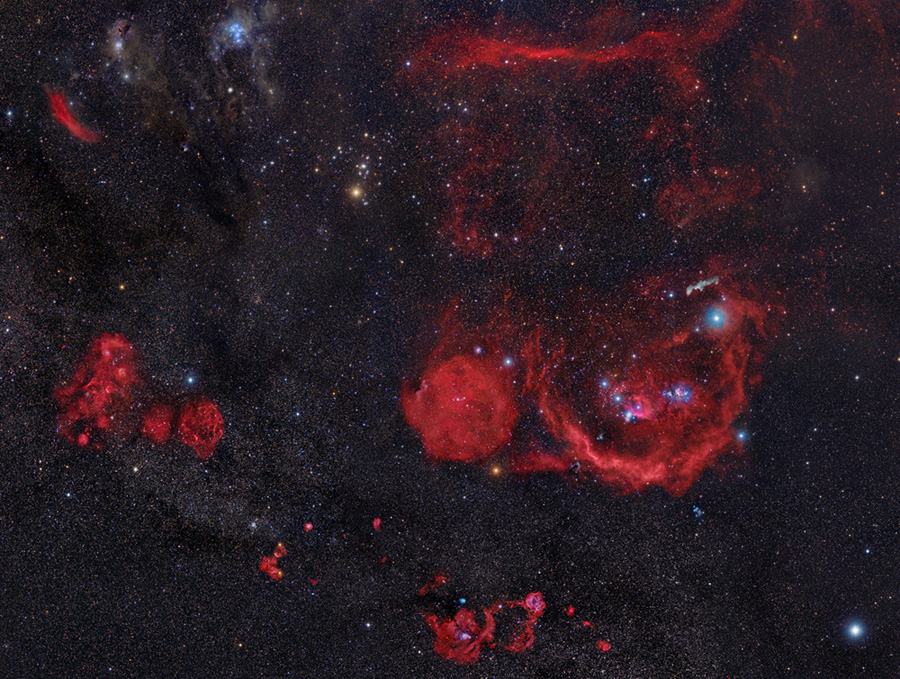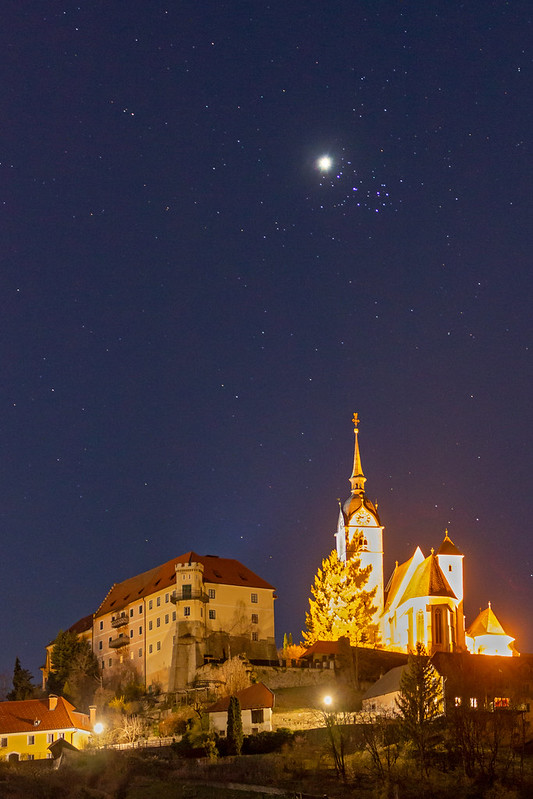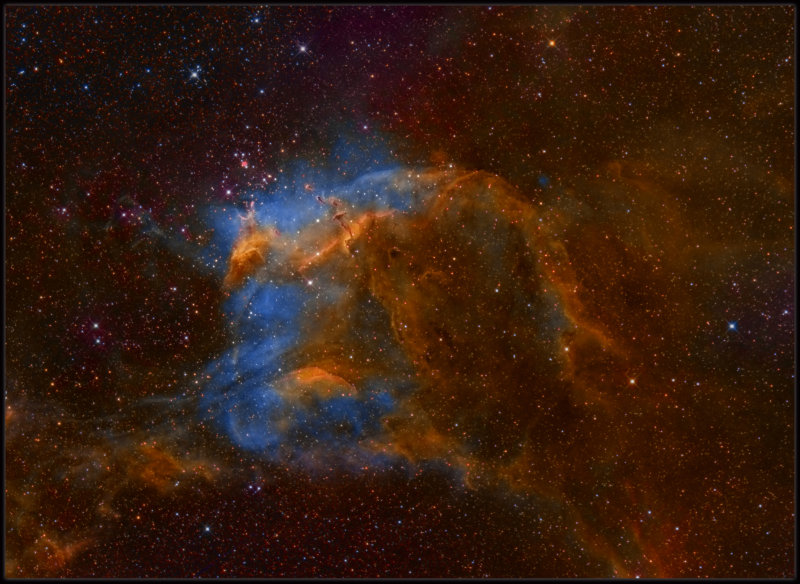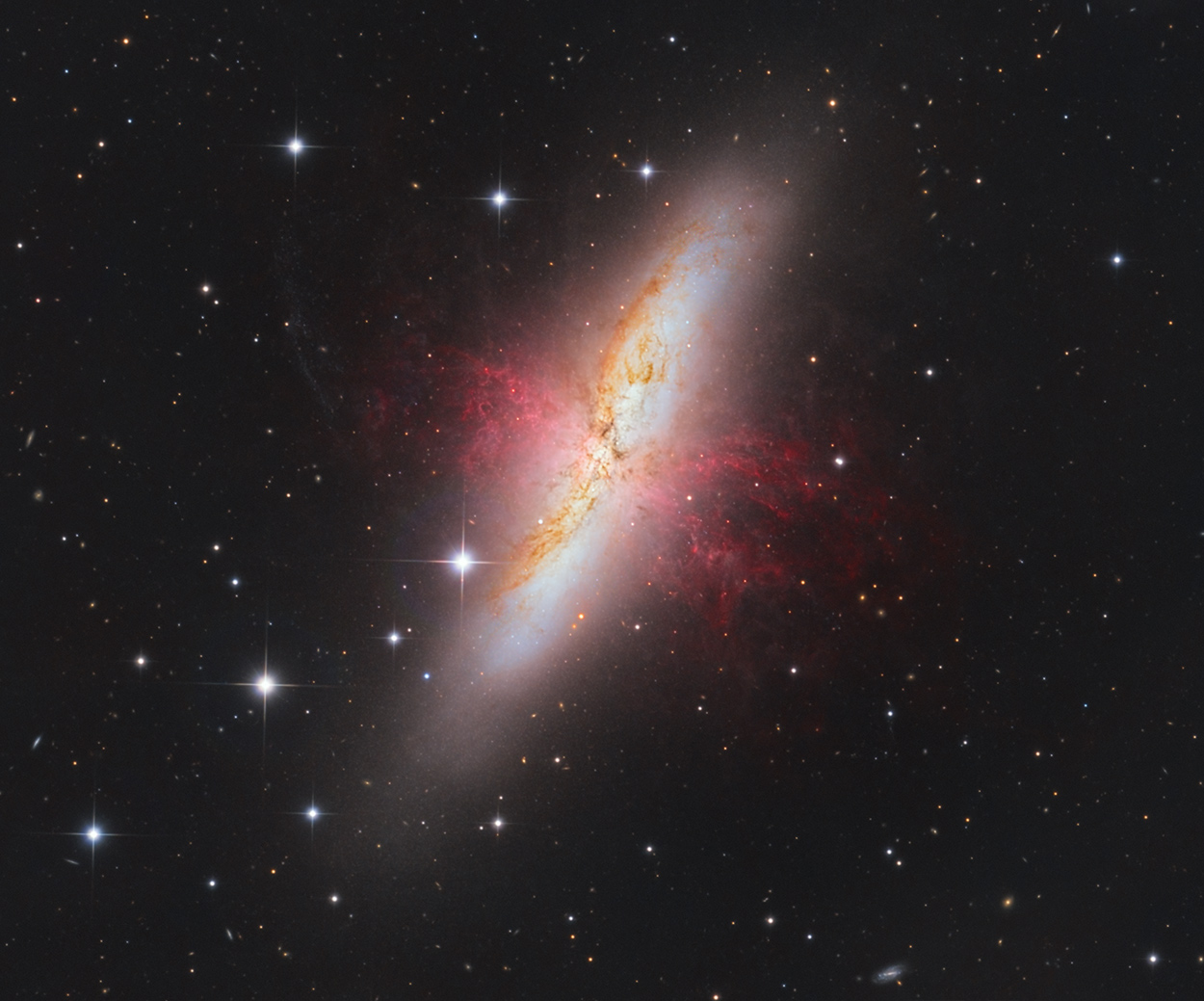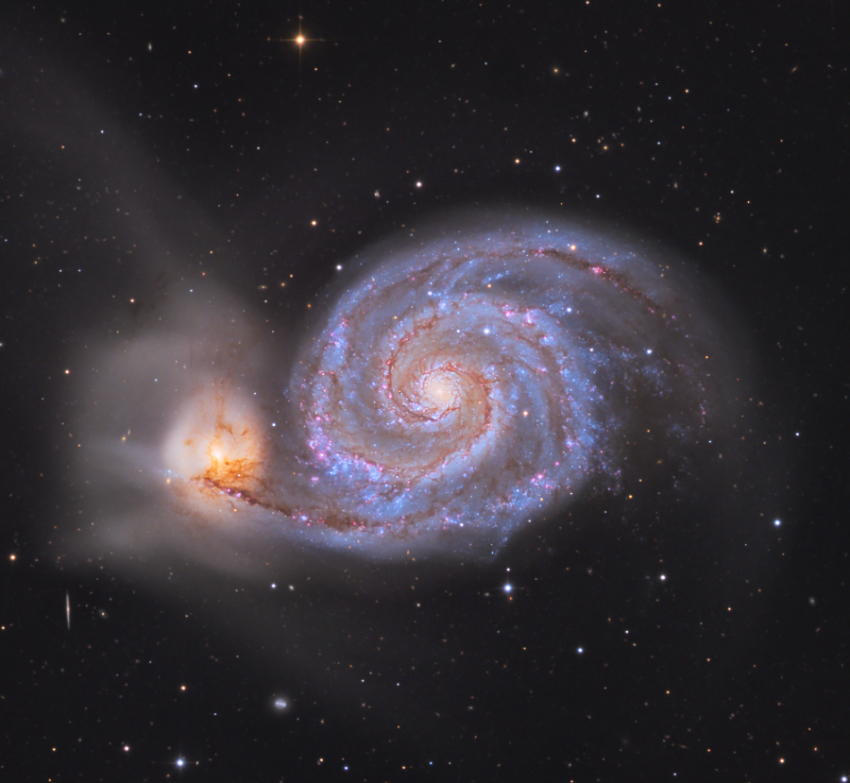Submissions: 2020 April
Re: Submissions: 2020 April
Region around Orion
http://www.woodlandsobservatory.com
Copyright: Alistair Symon I have been working on this very wide image of the Orion region on and off for the last 18 months. Its a mosaic taken with 70mm and 35mm camera lenses as well as 5 inch and 4 inch refractors. To give you an idea of how this image was assembled it's a 9 image mosaic for the overall star background taken with a 35mm camera lens. Then embedded within it are other mosaics. There is a 4 image mosaic of Orion taken with a 70mm camera lens. Then within that mosaic is another 4 image mosaic of the Horsehead and M42 taken with a 4 inch refractor. The area around the Rosette and Cone is a 10 image mosaic taken with a 5 inch refractor. There are also other images and mosaics in there taken with the 4 and 5 inch refractors (e.g. California, Seven Sisters, Flaming Star, Tadpole, Jellyfish, Monkeyhead, Witch Head, Moldy Strawberry). So in all this is hundreds of hours of data collection all assembled together. You can find a higher resolution image here:
http://www.woodlandsobservatory.com/Ori ... de2019.htm
http://www.woodlandsobservatory.com
Copyright: Alistair Symon I have been working on this very wide image of the Orion region on and off for the last 18 months. Its a mosaic taken with 70mm and 35mm camera lenses as well as 5 inch and 4 inch refractors. To give you an idea of how this image was assembled it's a 9 image mosaic for the overall star background taken with a 35mm camera lens. Then embedded within it are other mosaics. There is a 4 image mosaic of Orion taken with a 70mm camera lens. Then within that mosaic is another 4 image mosaic of the Horsehead and M42 taken with a 4 inch refractor. The area around the Rosette and Cone is a 10 image mosaic taken with a 5 inch refractor. There are also other images and mosaics in there taken with the 4 and 5 inch refractors (e.g. California, Seven Sisters, Flaming Star, Tadpole, Jellyfish, Monkeyhead, Witch Head, Moldy Strawberry). So in all this is hundreds of hours of data collection all assembled together. You can find a higher resolution image here:
http://www.woodlandsobservatory.com/Ori ... de2019.htm
Re: Submissions: 2020 April
The M64 Galaxy, a LRGB/color image taken 18->20 April 2020
http://www.astro-hp.dk/
Copyright: Niels V. Christensen
http://www.astro-hp.dk/
Copyright: Niels V. Christensen
-
cappellettiariel
- Ensign
- Posts: 21
- Joined: Sat Aug 11, 2018 3:18 pm
Re: Submissions: 2020 April
Hi Everyone, good afternoon, I would like to submit this image of NGC 3324 - Gabriela Mistral Nebula in Hubble Palette
16.5 h of total integration, from Córdoba, Argentina
Main equipment: ZWO ASI 1600 mm-pro + SW Explorer 200p + SW Coma Corrector 0.9x + EQ6-R-Pro + Long Perng 2" Dual Speed Low Profile Crayford Focuser + ZWO EAF + ZWO 7x2" EFW
Guide equipment: guidescope 60/240 mm, ZWO ASI 120mm mini
*Gain 139, -25 º C, Ha 7nm 2" Optolong, 160x180"
*Gain 139, -25 º C, Oiii-CCD 6.5 nm 2" Optolong, 85x180"
*Gain 139, -25 º C, Sii-CCD 6.5 nm 2" Optolong, 85x180"
100 Darks
100 Flats / filter
100 DarkFlats
Polar Align: SharpCap 3.2
Acquisition: SGP 3.1
Processing: Pixinsight 1.8.8, PS
Hope you enjoy it, clear skies!
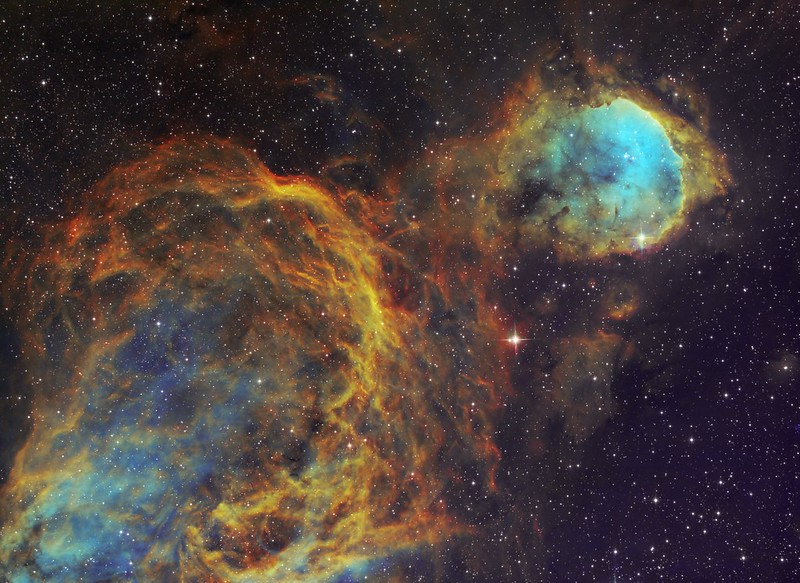
NGC324 - Gabriela Mistral Nebula in SHO by Ariel Cappelletti, en Flickr
16.5 h of total integration, from Córdoba, Argentina
Main equipment: ZWO ASI 1600 mm-pro + SW Explorer 200p + SW Coma Corrector 0.9x + EQ6-R-Pro + Long Perng 2" Dual Speed Low Profile Crayford Focuser + ZWO EAF + ZWO 7x2" EFW
Guide equipment: guidescope 60/240 mm, ZWO ASI 120mm mini
*Gain 139, -25 º C, Ha 7nm 2" Optolong, 160x180"
*Gain 139, -25 º C, Oiii-CCD 6.5 nm 2" Optolong, 85x180"
*Gain 139, -25 º C, Sii-CCD 6.5 nm 2" Optolong, 85x180"
100 Darks
100 Flats / filter
100 DarkFlats
Polar Align: SharpCap 3.2
Acquisition: SGP 3.1
Processing: Pixinsight 1.8.8, PS
Hope you enjoy it, clear skies!

NGC324 - Gabriela Mistral Nebula in SHO by Ariel Cappelletti, en Flickr
Last edited by cappellettiariel on Mon Apr 20, 2020 10:08 pm, edited 2 times in total.
-
cappellettiariel
- Ensign
- Posts: 21
- Joined: Sat Aug 11, 2018 3:18 pm
Re: Submissions: 2020 April
Hi Everyone, good afternoon, I would like to submit this image of NGC 3532 - The Wishing Well Star Cluster from sky Bortle 9 in LRHaGB
4 h of total integration, from Córdoba, Argentina
Main equipment: ZWO ASI 1600 mm-pro + SW Explorer 200p + SW Coma Corrector 0.9x + EQ6-R-Pro + Long Perng 2" Dual Speed Low Profile Crayford Focuser + ZWO EAF + ZWO 7x2" EFW
Guiding Equipment: guidescope 60/240 mm, ZWO ASI 120mm mini
*Gain 100, -25 º C, L 2" Optolong, 360x15"
*Gain 100, -25 º C, R-CCD 2" Svbony, 120x15"
*Gain 100, -25 º C, G-CCD 2" Svbony, 120x15"
*Gain 100, -25 º C, B-CCD 2" Svbony, 120x15"
*Gain 139, -25 º C, Ha 7nm 2" Optolong, 20x180"
100 Darks
100 Flats / filter
100 DarkFlats
Polar Align: SharpCap 3.2
Acquisition: SGP 3.1
Processing: Pixinsight 1.8.8, PS
Hope you enjoy it, clear skies!
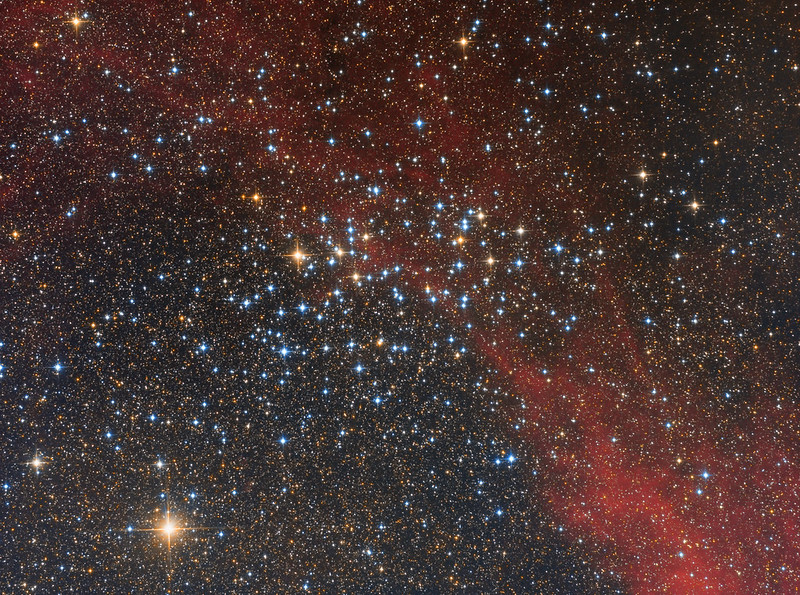
NGC 3532 - LRHaGB - Wishing Well Star Cluster by Ariel Cappelletti, en Flickr
4 h of total integration, from Córdoba, Argentina
Main equipment: ZWO ASI 1600 mm-pro + SW Explorer 200p + SW Coma Corrector 0.9x + EQ6-R-Pro + Long Perng 2" Dual Speed Low Profile Crayford Focuser + ZWO EAF + ZWO 7x2" EFW
Guiding Equipment: guidescope 60/240 mm, ZWO ASI 120mm mini
*Gain 100, -25 º C, L 2" Optolong, 360x15"
*Gain 100, -25 º C, R-CCD 2" Svbony, 120x15"
*Gain 100, -25 º C, G-CCD 2" Svbony, 120x15"
*Gain 100, -25 º C, B-CCD 2" Svbony, 120x15"
*Gain 139, -25 º C, Ha 7nm 2" Optolong, 20x180"
100 Darks
100 Flats / filter
100 DarkFlats
Polar Align: SharpCap 3.2
Acquisition: SGP 3.1
Processing: Pixinsight 1.8.8, PS
Hope you enjoy it, clear skies!

NGC 3532 - LRHaGB - Wishing Well Star Cluster by Ariel Cappelletti, en Flickr
-
Victor Lima
- Ensign
- Posts: 70
- Joined: Tue Apr 21, 2020 11:38 am
Re: Submissions: 2020 April
Hello Mark,markh@tds.net wrote: ↑Wed Apr 01, 2020 3:30 pm Sombrero Galaxy - M104
Copyright Mark Hanson
Here is an image taken by Martin Pugh and processed by me. The image has exquisite detail and is amazing for an amateur telescope to achieve.
M104-No HaWebsmall.jpg
Take a look at the full resolution image here: https://www.hansonastronomy.com/m-104
Thank you,
Mark Hanson
This is a incredible image mate! Great job here!
Best,
Victor Lima
-
Victor Lima
- Ensign
- Posts: 70
- Joined: Tue Apr 21, 2020 11:38 am
Re: Submissions: 2020 April
Really great job, Ariel. Congratulations from Brazil.cappellettiariel wrote: ↑Mon Apr 20, 2020 9:57 pm Hi Everyone, good afternoon, I would like to submit this image of NGC 3324 - Gabriela Mistral Nebula in Hubble Palette
16.5 h of total integration, from Córdoba, Argentina
Main equipment: ZWO ASI 1600 mm-pro + SW Explorer 200p + SW Coma Corrector 0.9x + EQ6-R-Pro + Long Perng 2" Dual Speed Low Profile Crayford Focuser + ZWO EAF + ZWO 7x2" EFW
Guide equipment: guidescope 60/240 mm, ZWO ASI 120mm mini
*Gain 139, -25 º C, Ha 7nm 2" Optolong, 160x180"
*Gain 139, -25 º C, Oiii-CCD 6.5 nm 2" Optolong, 85x180"
*Gain 139, -25 º C, Sii-CCD 6.5 nm 2" Optolong, 85x180"
100 Darks
100 Flats / filter
100 DarkFlats
Polar Align: SharpCap 3.2
Acquisition: SGP 3.1
Processing: Pixinsight 1.8.8, PS
Hope you enjoy it, clear skies!
NGC324 - Gabriela Mistral Nebula in SHO by Ariel Cappelletti, en Flickr
Victor Lima
-
Victor Lima
- Ensign
- Posts: 70
- Joined: Tue Apr 21, 2020 11:38 am
Re: Submissions: 2020 April
What a incredible view!!! Amazing!!!Bobinius wrote: ↑Sun Apr 19, 2020 2:10 pm Interacting Galaxies in Andromeda: Arp 273 from HST
Credit: NASA/ESA/Hubble
Processing: Bogdan Borz 2020
Full resolution: https://www.astrobin.com/full/5f0vwq/0/?nc=user
Interacting Galaxies in Andromeda: Arp 273 from HST by Bogdan Borz
-
Victor Lima
- Ensign
- Posts: 70
- Joined: Tue Apr 21, 2020 11:38 am
Re: Submissions: 2020 April
Beautiful image Stefano!!Stefano Ricca wrote: ↑Thu Apr 02, 2020 9:44 am Location: Valle Ellero, Italy
Date: 10 August 2018
Copyright: Stefano Ricca
WebSite: www.stefanoriccaphoto.com
https://i.ibb.co/ss71Fwy/Milky-Valle-Ellero-Copy.jpg
Victor Lima
-
Victor Lima
- Ensign
- Posts: 70
- Joined: Tue Apr 21, 2020 11:38 am
Re: Submissions: 2020 April
Really beautiful shot! Congrats!herbraab wrote: ↑Sun Apr 05, 2020 10:47 am Venus and the Pleiades over Althofen (Carinthia, Austria).
Single shot. No tracking, no stacking, no blending.
Venus and the Pleiades by H. Raab, on Flickr
-
Victor Lima
- Ensign
- Posts: 70
- Joined: Tue Apr 21, 2020 11:38 am
Re: Submissions: 2020 April
I really love this two versions, great job!tango33 wrote: ↑Sat Apr 04, 2020 10:39 pm 2 Versions of NGC 3572:
Full resolution RGB:
https://pbase.com/tango33/image/170169772/original
Full resolution Hubble color mapping:
https://pbase.com/tango33/image/170169774/original
Cheers,
Kfir Simon
-
Victor Lima
- Ensign
- Posts: 70
- Joined: Tue Apr 21, 2020 11:38 am
Re: Submissions: 2020 April
Linda imagem Fernando! Parabens!!barretosmed wrote: ↑Tue Apr 07, 2020 7:35 pm The Grus Quartet (Galaxy) (NGC 7552, 7582, 7590, 7599)
Located in the Grus Constellation, are all 4 spiral galaxies.
Further up we have NGC 7552, the smallest of the three below is ngc 7590, with its mate next to ngc 7599. The most central and most studied of them is NGC 7582.
NGC 7582 is a type 2 Seyfert galaxy, such a classification is due to the fact that the galaxy has an extremely bright supermassive central black hole very similar to a quasar (most energetic objects in the universe). The black hole of NGC7582 is about 10 million times the mass of our sun.
Best details:
https://www.astrobin.com/full/0jgu5p/F/?nc=user
Equipment:
Apo 150mm triplet
Qhy 16200
15 L 500 "
43 RGB 300 "
Processing and Capture:
Software: PixInsight, Adobe Photoshop, APT, PHD, Polemaster, Sharcap
07/27/2019
Munhoz - MG - Brazil
Copyright: Fernando Oliveira de Menezes
Email: Barretosmed@hotmail.com
-
Victor Lima
- Ensign
- Posts: 70
- Joined: Tue Apr 21, 2020 11:38 am
Re: Submissions: 2020 April
I love the colors and processing in this image! Fantastic!rhess wrote: ↑Sat Apr 11, 2020 10:15 am M 82 ( Cigar Galaxy ) is a starburst galaxy approximately 12 million light-years away in the constellation Ursa Major
Telescope: ASA EQ1000 f7 - ASA 1 m equatorial telescope
Location: Vega Observatory - House of Nature Salzburg, Austria
Camera: FLI Microline 16803
Exposure time: 49x7min. Luminance, 35x20min Ha, 30x7min.RGB all unbinned
Copyright: Rochus Hess larger resolution
http://www.astrofotografie-hess.at/m82.html
Website
http://www.astrofotografie-hess.at/
-
Victor Lima
- Ensign
- Posts: 70
- Joined: Tue Apr 21, 2020 11:38 am
Re: Submissions: 2020 April
Fantastic Carlos! I love the colors in this image!carlos uriarte wrote: ↑Tue Apr 14, 2020 11:05 am Hi! here has a california nebula
Captured with Takahashi FSQ106ED and LRGB and Ha combination filters
42 subframes 300" with astrodon 5nm
25 subframes 180" each astrodon LRGB
with Darks, bias, flats, and processed in Pixinsight and Photoshop CC2020.
Captured in Torroja del Priorat, Spain, last year, and processed few days ago.
NGC 1499 California Nebula by Carlos Uriarte, en Flickr
-
Victor Lima
- Ensign
- Posts: 70
- Joined: Tue Apr 21, 2020 11:38 am
Re: Submissions: 2020 April
Great image of M27 Alberto! Congrats!AlbertoP wrote: ↑Sun Apr 19, 2020 7:02 pm M27 Dumbbell Nebula
www.loscoloresinvisibles.com
Copyright: Alberto Pisabarro
M27_HORGB.jpg
Full Resolution:https:https://astrob.in/full/8sja4n/0/?nc=silkpericles&real=
Combined image using HORGB data in total is 22.3 hours of exposure with an A-P RH305 telescope,16803 sensor.
-
cappellettiariel
- Ensign
- Posts: 21
- Joined: Sat Aug 11, 2018 3:18 pm
Re: Submissions: 2020 April
Muito Obrigado Victor!!!Victor Lima wrote: ↑Tue Apr 21, 2020 12:06 pm Really great job, Ariel. Congratulations from Brazil.
Victor Lima
-
Victor Lima
- Ensign
- Posts: 70
- Joined: Tue Apr 21, 2020 11:38 am
Re: Submissions: 2020 April
Piedras Rojas
Piedras Rojas is one of the most visited places by tourists visiting the Atacama Desert in Chile.
Despite the beautiful scenery that can be enjoyed during the day, it is during the night that the show takes place. Above 4300 meters above sea level and far from any source of light pollution, watching the night sky from there is an unforgettable experience.
In this self-portrait made in April/16, we can identify the planets Mars and Saturn, just above the Milky Way core. In addition, we can see a beautiful Air Glow ranging from green to red tones giving a special color to the sky of Piedras Rojas.
Single Shot
Canon 6D / EF 16-35mm f/2.8L II USM
16mm / f:2.8 / 30sec / ISO 6400
Piedras Rojas is one of the most visited places by tourists visiting the Atacama Desert in Chile.
Despite the beautiful scenery that can be enjoyed during the day, it is during the night that the show takes place. Above 4300 meters above sea level and far from any source of light pollution, watching the night sky from there is an unforgettable experience.
In this self-portrait made in April/16, we can identify the planets Mars and Saturn, just above the Milky Way core. In addition, we can see a beautiful Air Glow ranging from green to red tones giving a special color to the sky of Piedras Rojas.
Single Shot
Canon 6D / EF 16-35mm f/2.8L II USM
16mm / f:2.8 / 30sec / ISO 6400
-
maphilli14
- Ensign
- Posts: 35
- Joined: Tue May 08, 2012 2:32 am
Re: Submissions: 2020 April
Starlink satellite animation from Raleigh, NC
https://maphilli14.webs.com/
Copyright: Michael Alexander Phillips
https://maphilli14.webs.com/
Copyright: Michael Alexander Phillips
Re: Submissions: 2020 April
M51 - Whirlpool-Galaxie
Telescope: ASA EQ1000 f7 - ASA 1 m equatorial telescope
Location: Vega Observatory - House of Nature Salzburg, Austria
Camera: FLI Microline 16803
Exposure time: 28x7min. Luminance, 9x7min.RGB all unbinned
Copyright: Rochus Hess larger resolution
http://www.astrofotografie-hess.at/m51.html
Website
http://www.astrofotografie-hess.at/
Telescope: ASA EQ1000 f7 - ASA 1 m equatorial telescope
Location: Vega Observatory - House of Nature Salzburg, Austria
Camera: FLI Microline 16803
Exposure time: 28x7min. Luminance, 9x7min.RGB all unbinned
Copyright: Rochus Hess larger resolution
http://www.astrofotografie-hess.at/m51.html
Website
http://www.astrofotografie-hess.at/
Last edited by rhess on Tue Apr 21, 2020 9:15 pm, edited 1 time in total.
Re: Submissions: 2020 April
Thank you Victor !Victor Lima wrote: ↑Tue Apr 21, 2020 12:18 pmI love the colors and processing in this image! Fantastic!rhess wrote: ↑Sat Apr 11, 2020 10:15 am M 82 ( Cigar Galaxy ) is a starburst galaxy approximately 12 million light-years away in the constellation Ursa Major
Telescope: ASA EQ1000 f7 - ASA 1 m equatorial telescope
Location: Vega Observatory - House of Nature Salzburg, Austria
Camera: FLI Microline 16803
Exposure time: 49x7min. Luminance, 35x20min Ha, 30x7min.RGB all unbinned
Copyright: Rochus Hess larger resolution
http://www.astrofotografie-hess.at/m82.html
Website
http://www.astrofotografie-hess.at/
-
barretosmed
- Science Officer
- Posts: 482
- Joined: Thu Oct 12, 2017 6:04 pm
Re: Submissions: 2020 April
Cleomedes crater
Its internal mountains have a very peculiar aspect, it even looks like a person lying down
More details:
https://www.astrobin.com/full/qmxkjs/0/ ... do_Menezes
Equipments
Meade LX 200 10 "
Asi 290mc
Filter Moon baader
Sao Paulo-SP-Brazil
04/08/2020 23:59
Copyright: Fernando Oliveira de Menezes
Email: Barretosmed@hotmail.com
Its internal mountains have a very peculiar aspect, it even looks like a person lying down
More details:
https://www.astrobin.com/full/qmxkjs/0/ ... do_Menezes
Equipments
Meade LX 200 10 "
Asi 290mc
Filter Moon baader
Sao Paulo-SP-Brazil
04/08/2020 23:59
Copyright: Fernando Oliveira de Menezes
Email: Barretosmed@hotmail.com
Re: Submissions: 2020 April
Galaxies of Arp 296 and Arp 299
These two sets of interacting galaxies are listed in Halton Arp’s Atlas of Peculiar Galaxies as Arp 296 and Arp 299.
Arp 299 is the larger set at the center of the image and consists of NGC 3690 and IC 694. There are numerous peer-reviewed publications on Arp 299 that discuss regions of powerful starburst activity, as well as eight supernovae detected during 1990 – 2010. An article published in August 2018 reports a possible tidal disruption event (TDE) “produced when a star is ripped apart by the gravitational field of a supermassive black hole (SMBH)” [https://science.sciencemag.org/content/ ... 1/482.full]. Arp 299 is approximately 130 million light-years away.
Arp 296 is at the right of center in the image and consists of a quite distinct barred face-on spiral galaxy (PGC 35345) and a less distinct galaxy (PGC 2580146) exhibiting filamentary structure on either side. Arp 296 is much further away than Arp 299 at an approximate distance of 800 million light-years.
I found very few on-line images of this field. The most prominent are a broadband image of Arp 299 from the Hubble telescope as well as hybrid images combining Hubble data with x-ray data from NuSTAR and Chandra. I have found no images that show the broad tail stretching from Arp 299 to the blue star at lower right in my image. The Hubble-based images and others published in professional literature tend to be tightly centered on Arp 299 and do not show the wider field. There are many other galaxies visible within this field.
I hope you enjoy the image!
Nick Pavelchak
https://www.astrobin.com/bnmaul/
These two sets of interacting galaxies are listed in Halton Arp’s Atlas of Peculiar Galaxies as Arp 296 and Arp 299.
Arp 299 is the larger set at the center of the image and consists of NGC 3690 and IC 694. There are numerous peer-reviewed publications on Arp 299 that discuss regions of powerful starburst activity, as well as eight supernovae detected during 1990 – 2010. An article published in August 2018 reports a possible tidal disruption event (TDE) “produced when a star is ripped apart by the gravitational field of a supermassive black hole (SMBH)” [https://science.sciencemag.org/content/ ... 1/482.full]. Arp 299 is approximately 130 million light-years away.
Arp 296 is at the right of center in the image and consists of a quite distinct barred face-on spiral galaxy (PGC 35345) and a less distinct galaxy (PGC 2580146) exhibiting filamentary structure on either side. Arp 296 is much further away than Arp 299 at an approximate distance of 800 million light-years.
I found very few on-line images of this field. The most prominent are a broadband image of Arp 299 from the Hubble telescope as well as hybrid images combining Hubble data with x-ray data from NuSTAR and Chandra. I have found no images that show the broad tail stretching from Arp 299 to the blue star at lower right in my image. The Hubble-based images and others published in professional literature tend to be tightly centered on Arp 299 and do not show the wider field. There are many other galaxies visible within this field.
I hope you enjoy the image!
Nick Pavelchak
https://www.astrobin.com/bnmaul/
Re: Submissions: 2020 April
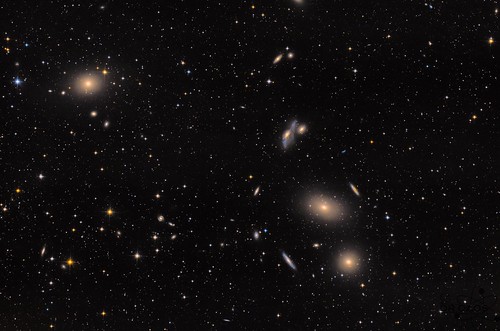 Cadena de Markarian by Fernando Peña, on Flickr
Cadena de Markarian by Fernando Peña, on FlickrTakahashi Epsilon 160 f3.3
Celestron CGEM
Rigel Nstep
canon t3i DIY cooling -15 °c
52 x 300s ISO 800
Darks, flats, bias-flats
Astropi3 running in Rpi 4
Siril, Darktable
Mixtlan Jalisco, 19/04/2020
-
Victor Lima
- Ensign
- Posts: 70
- Joined: Tue Apr 21, 2020 11:38 am
Re: Submissions: 2020 April
Milky way over Lagunas Baltinache, Atacama Desert in Chile.
Mars and Saturn are visible just above the MW core.
Vertical Panorama
Canon 6D / EF 16-35mm f/2.8L II
4x 16mm / f:2.8 / 30 sec / ISO 3200
Mars and Saturn are visible just above the MW core.
Vertical Panorama
Canon 6D / EF 16-35mm f/2.8L II
4x 16mm / f:2.8 / 30 sec / ISO 3200
-
Victor Lima
- Ensign
- Posts: 70
- Joined: Tue Apr 21, 2020 11:38 am
Re: Submissions: 2020 April
Amazing night in Mangue Seco, Brazil (March 2018).
The Mangue Seco dunes gained fame in Brazil in the 90s due to the exhibition of a soap opera of great audience recorded in the place. In addition to the beauty of the dunes, Mangue Seco also offers excellent conditions for capturing the night sky, especially when the Milky Way core appears on the horizon over the sea. In this image, the light emitted by an operating oil platform painted the horizon in the left corner of orange.
Single Shot
Canon 6D / EF 16-35mm f/2.8L II
16mm / f:2.8 / 30sec / ISO 4000
The Mangue Seco dunes gained fame in Brazil in the 90s due to the exhibition of a soap opera of great audience recorded in the place. In addition to the beauty of the dunes, Mangue Seco also offers excellent conditions for capturing the night sky, especially when the Milky Way core appears on the horizon over the sea. In this image, the light emitted by an operating oil platform painted the horizon in the left corner of orange.
Single Shot
Canon 6D / EF 16-35mm f/2.8L II
16mm / f:2.8 / 30sec / ISO 4000
-
Victor Lima
- Ensign
- Posts: 70
- Joined: Tue Apr 21, 2020 11:38 am
Re: Submissions: 2020 April
The moon illuminates the Baltinache Lagoons during an incredible night in the Atacama Desert in Chile.
Although the moon's luminosity somewhat disturbs the capture of the night sky, it is possible to identify the magellanic clouds on the right in the image.
Single Shot
Canon 6D / EF 16-35mm f/2.8L II USM
16mm / f:2.8 / 30sec / ISO 1600
Although the moon's luminosity somewhat disturbs the capture of the night sky, it is possible to identify the magellanic clouds on the right in the image.
Single Shot
Canon 6D / EF 16-35mm f/2.8L II USM
16mm / f:2.8 / 30sec / ISO 1600
